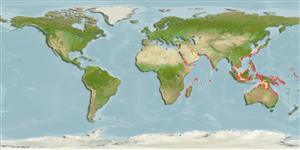Anomia achaeus Gray, 1805
| Native range | All suitable habitat | Point map | Year 2050 |

|
| This map was computer-generated and has not yet been reviewed. |
| Anomia achaeus AquaMaps Data sources: GBIF OBIS |
Google image | No image available for this species;
drawing shows typical species in Anomiidae.
Classification / Names Common names | Synonyms | CoL | ITIS | WoRMS
Bivalvia | Pectinida | Anomiidae
Environment: milieu / climate zone / depth range / distribution range Ecology
Benthic; depth range 0 - 45 m (Ref. 107597), usually 0 - 5 m (Ref. 53). Subtropical
Distribution Countries | FAO areas | Ecosystems | Occurrences | Introductions
Indo-West Pacific: China.
Length at first maturity / Size / Weight / Age
Maturity: Lm ? range ? - ? cm
Life cycle and mating behavior Maturity | Reproduction | Spawning | Eggs | Fecundity | Larvae
Main reference
References | Coordinator | Collaborators
Gray, J.E. 1850 On the species of Anomiidae. Proceedings of the Zoological Society of London (for 1849) Part 18:113-125. (Ref. 77659)
IUCN Red List Status
(Ref. 130435: Version 2025-1)
CITES status (Ref. 108899)
CMS (Ref. 116361)
Threat to humans
Human uses
| FishSource |
Tools
More information
Diet composition
Food consumption
Predators
Max. ages / sizes
Length-weight rel.
Length-length rel.
Length-frequencies
Mass conversion
Abundance
Internet sources
BHL | BOLD Systems | CISTI | DiscoverLife | FAO(Publication : search) | Fishipedia | GenBank (genome, nucleotide) | GloBI | Gomexsi | Google Books | Google Scholar | Google | PubMed | Tree of Life | Wikipedia (Go, Search) | Zoological Record



